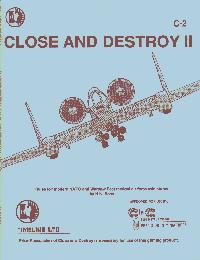

This 68-page booklet is the air supplement to Close And Destroy, adding tactical air and helicopters (as well as ground-based air defense systems) to the game.
The designers contend that most other rulesets fall into two types: "...those in which tac air is magical and those in which it is inconsequential. In the magical type the appearance of air over the board causes all the ground units to run for cover, as the aircraft are going to kill everything right now. In the other case, everybody ignores the approaching aircraft as they can do little, if anything, to the guys on the ground."
Fixed-wing aircraft must move in a straight line at their maximum movement rate, and (depending on the size of the playing area) usually leave in the same phase that they arrive. Altitude can vary from 1000 to 50 meters. Rules cover two methods of attack (the diving approach and the lay-down approach), bombing, strafing, and the use of unguided missiles.
Rotary-wing aircraft operate in much the same manner as fixed-wing aircraft, except that they can move freely and are not forced to use their maximum speed, and they do not use the various attack approaches.
Ground weapons which can fire at aircraft include anti-aircraft machineguns (pintle- or turret-mounted guns), dedicated anti-aircraft gun stands, and anti-aircraft missile stands. All stands fire individually. Rules cover the use of radar (which may be on or off per stand), visibility (for instance, a "buttoned up" SPAD Vulcan cannot fire), and movement of firer. Surface-to-air missiles (SAMs) may attack immediately if the target is at short range; otherwise, the attack occurs in a following phase, giving the target an opportunity to move out of range. Target facing may affect a SAM's chance of attacking -- for instance, a Grail hand-held SAM is only effective if fired at the rear facing of an aircraft.
Anti-aircraft fire consists of a to-hit roll followed by a to-kill roll. The To-Hit Table matches the firing weapon with the range and target class (which depends on whether the aircraft is fixed wing or rotary, facing, and movement), and generates a percentage chance. If a hit is scored, the To-Kill Table correlates the specific target type against the general category of firing weapon and produces a kill chance -- if the roll fails, the aircraft takes no damage.
For example: Warsaw Pact infantry in a BTR-50 APC fire their 12.7 heavy machinegun (HMG) at an attacking AH-1 Cobra helicopter 300 meters away. The target is Category E (rotary wing, moving, seen from the front), and the To-Hit chance is 40%. In our case, the Soviet player makes his roll ("20") and hits. On the To-Kill Table, the chance of an HMG bringing down a Cobra is listed as 30%. However, our player rolls "98" -- the Cobra survives.
Also found in this booklet are:
| Last Updates | |
|---|---|
| 22 July 1996 | reformatted |
| 15 April 1996 | reorganized |
| Comments or corrections? | |